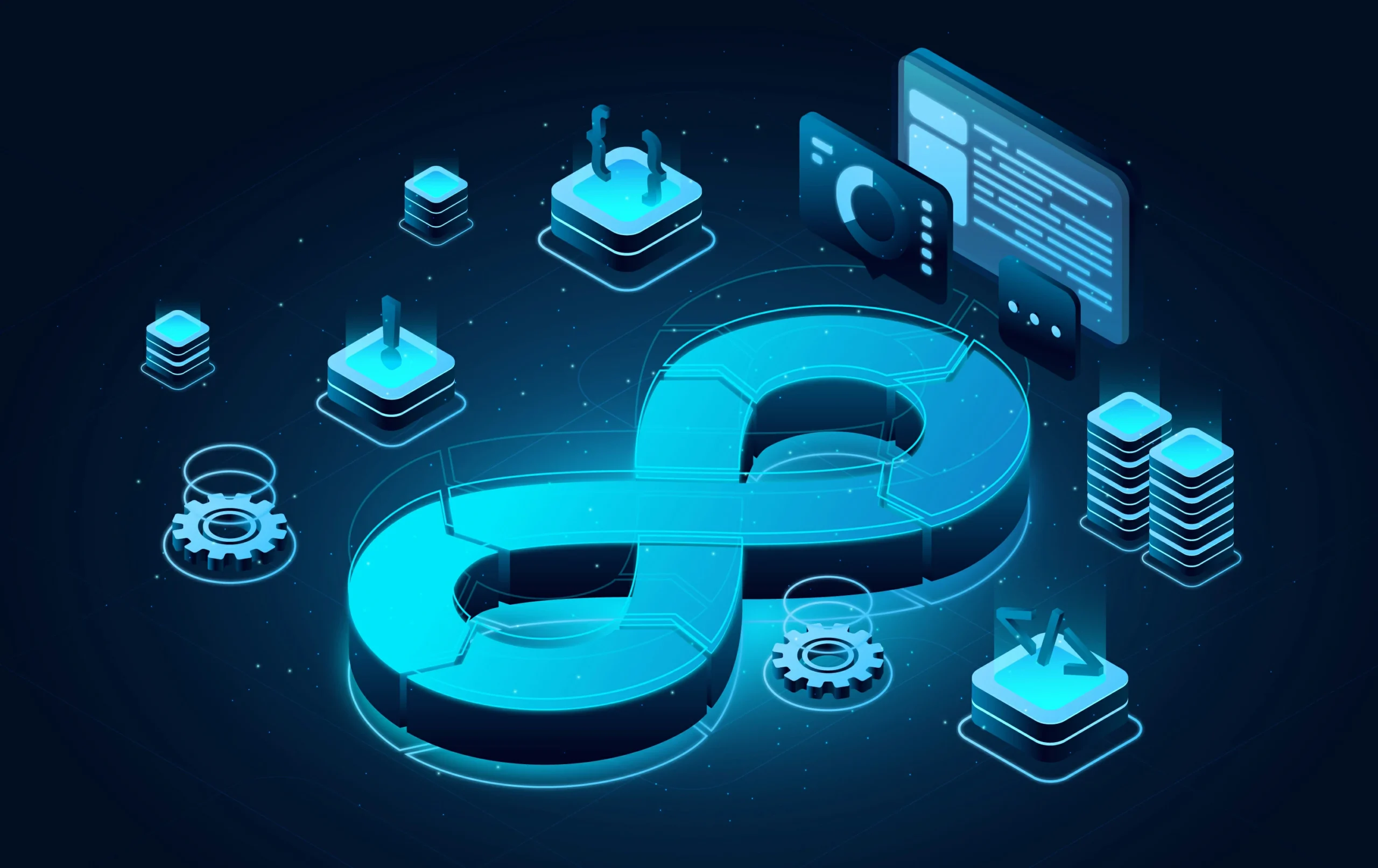Beyond CI/CD: How DevOps is Shaping the Future of IT Operations
1. Infrastructure as Code (IaC): Automating Infrastructure Management
One of the most impactful ways DevOps is transforming IT operations is through Infrastructure as Code (IaC). IaC allows teams to manage and provision infrastructure programmatically, meaning entire environments can be replicated, scaled, or modified with ease. This shift from manual provisioning to automation not only accelerates deployment but also ensures consistency, allowing IT teams to manage complex infrastructures with minimal risk of human error efficiently.
Key Benefits:
- Faster and more reliable environment setups
- Reduced manual configuration errors
- Greater scalability and consistency
2. Enhanced Security with DevSecOps
As organizations handle more sensitive data, security is now a critical part of every DevOps pipeline. DevSecOps—integrating security into the DevOps workflow—is becoming the industry standard, embedding security checks throughout the development and operations processes. By addressing vulnerabilities early and automating security protocols, teams can significantly reduce risk, save costs, and maintain compliance.
DevSecOps Practices:
- Automated security scanning within the CI/CD pipeline
- Real-time monitoring for rapid threat detection/li>
- Continuous security audits and compliance checks
3. Increased Reliability through Continuous Monitoring and Observability
DevOps introduces a culture of continuous monitoring and observability, enabling teams to track system performance and detect issues in real time. Unlike traditional monitoring, which focuses on specific metrics, observability provides comprehensive insights into an application’s health and behavior. By leveraging tools like Prometheus, Grafana, and ELK Stack, teams can proactively troubleshoot issues before they impact end users, making systems more reliable and reducing downtime.
Why It Matters:
- Proactive issue detection and resolution
- Data-driven insights into system performance
- Improved user experience through reduced outages

4. DevOps and Cloud Computing: A Perfect Match for Scalability
The synergy between DevOps and cloud computing is shaping a new era of IT operations. Cloud providers like AWS, Azure, and Google Cloud offer scalable resources that align perfectly with DevOps practices, allowing teams to deploy applications at scale and manage resources on-demand. With cloud-native tools, organizations can adopt microservices, containerization, and serverless architectures, further enhancing scalability and resilience.
Advantages:
- Resource optimization and cost efficiency
- Rapid deployment across global regions
- Enhanced flexibility to experiment and innovate
5. Fostering Collaboration with a Culture-First Approach
DevOps emphasizes a collaborative culture that brings development, operations, and security teams together. This shift from siloed departments to cross-functional teams has changed the face of IT operations, fostering accountability and transparency at every level. By embracing shared responsibility, organizations can accelerate problem-solving, increase productivity, and drive continuous improvement.
Cultural Benefits:
- Accelerated innovation through collaborative efforts
- Increased transparency and shared responsibility
- Continuous feedback and iterative improvements
6. Accelerating Innovation with Automation and AI
Automation has always been a core component of DevOps, but the introduction of AI and machine learning is pushing automation to new heights. By using AI-driven insights, DevOps teams can automate everything from testing and deployments to anomaly detection and root-cause analysis. AI-driven automation helps teams move faster, reduces repetitive manual tasks, and enhances decision-making with predictive insights..
How AI Supports DevOps:
- Automated incident response through AI-powered monitoring
- Predictive analytics to foresee potential system failures
- Enhanced testing through AI-driven quality assurance, reducing bugs in production
The combination of automation and AI doesn’t just save time; it empowers DevOps teams to innovate and deliver new features rapidly, making IT operations smarter and more efficient.
7. Bridging the Gap with Hybrid and Multi-Cloud DevOps
Many organizations are moving toward hybrid and multi-cloud environments to improve flexibility and avoid vendor lock-in. DevOps practices are critical in managing and optimizing these complex infrastructures, providing a unified framework for continuous deployment across multiple platforms. By adopting DevOps in a multi-cloud context, teams can seamlessly move applications across environments, ensuring consistent performance and minimizing risks of downtime or data loss.
Benefits of Hybrid and Multi-Cloud DevOps:
- Enhanced disaster recovery and resilience
- Flexibility to optimize resource usage across different cloud providers
- Unified DevOps tools and processes that work across diverse environments
The future of IT operations will be increasingly multi-cloud, and DevOps will continue to be the backbone that keeps these environments cohesive and manageable.


8. Optimizing Cost Efficiency through DevOps
Another significant impact of DevOps on IT operations is cost optimization. DevOps practices—especially automation, IaC, and continuous monitoring—help organizations identify and eliminate inefficiencies in real time. By optimizing resources and automating workflows, teams can allocate resources where they’re most needed, reduce waste, and make better use of infrastructure.
Cost-Efficiency Strategies with DevOps:
- Automated scaling to adjust resources based on demand
- Real-time cost monitoring tools to manage cloud expenses
- Serverless architectures that reduce infrastructure overhead
By combining DevOps with cloud cost management practices, IT teams are able to maximize the impact of their budgets while ensuring optimal performance.
9. Strengthening Compliance and Governance
In heavily regulated industries, compliance and governance are top priorities. DevOps has introduced automated compliance as part of the deployment pipeline, reducing the time and effort needed to meet regulatory requirements. Automated compliance checks and audit trails are now embedded into DevOps workflows, ensuring that each release meets legal and regulatory standards.
DevOps Compliance Practices:
- Integration of automated compliance checks into the CI/CD pipeline
- Detailed audit logs and documentation for all changes
- Real-time compliance monitoring to ensure continuous adherence to regulations
By addressing compliance as part of the DevOps process, organizations are able to release software faster and with greater confidence, knowing that security and legal requirements are met.
10. Future-Proofing IT Operations with Continuous Improvement
The DevOps model promotes a mindset of continuous improvement that is essential for future-proofing IT operations. By constantly analyzing and optimizing processes, DevOps encourages teams to evolve with the latest technology, anticipate changes, and adapt to new challenges. This commitment to continuous learning and improvement enables IT teams to stay agile and competitive in a rapidly changing tech landscape.
Continuous Improvement Practices:
- Regular retrospectives and feedback loops for process refinement
- Adoption of new tools and methodologies as they emerge
- Encouraging a learning culture that embraces experimentation and innovation
Through continuous improvement, DevOps doesn’t just prepare teams for current challenges but ensures they are equipped for whatever the future brings.
Conclusion
DevOps has moved far beyond its initial focus on CI/CD, reshaping IT operations and setting new standards for agility, security, collaboration, and scalability. From infrastructure automation to continuous monitoring and cloud-native deployments, DevOps is driving organizations to be more responsive and resilient than ever before. By embracing these changes, organizations can not only streamline their operations but also accelerate innovation, optimize costs, and stay ahead in the fast-evolving digital landscape.
Follow us

